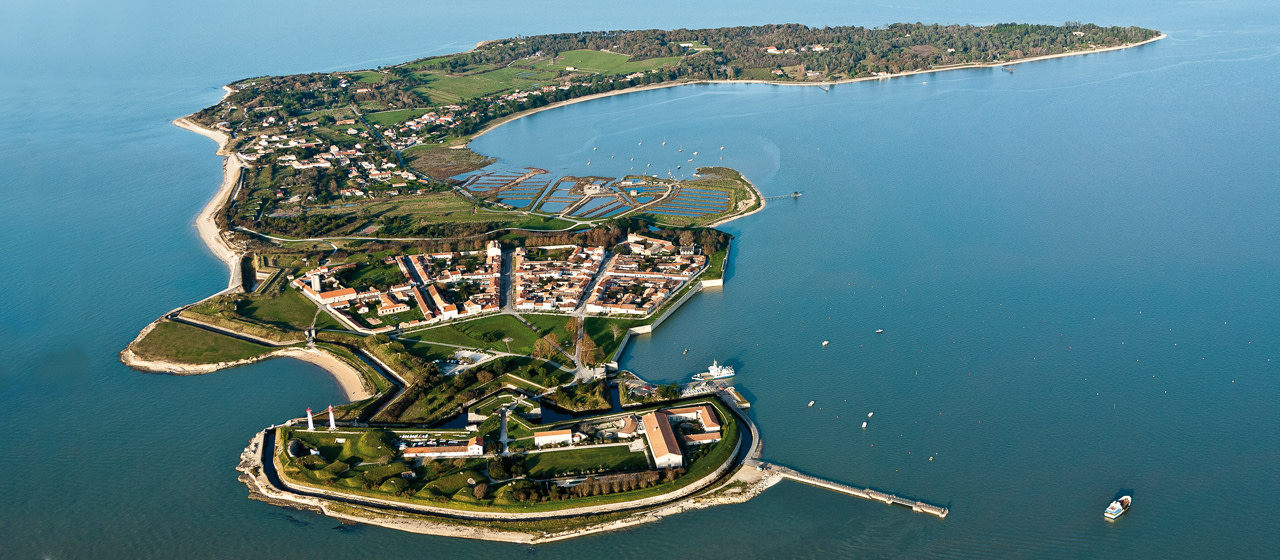
This small crescent-shaped island, 3 km long, is in fact the only real island of Charente-Maritime, Ré and Oléron being linked to the mainland by a bridge. You can reach it only by boat and if the car is not welcome, the bicycle, yes, even the carriage...
A very rich heritage...
The last French land where Napoleon stayed - he has his museum there -, Aix is a fortified island with its 17th century Fort de la Rade, Fort Liédot, numerous batteries and, within sight, the forts Boyard and Énet.
The Place d'Austerlitz and the Rue Napoléon are also reminders of Napoléon's short stay, three days before his exile to Saint Helena.
Another site of interest is an astonishing African museum designed by Baron Gourgaud.
The island of Aix, in addition to its low houses of preserved fishermen, its creeks, its beaches, it is also the battery of Jamblet and its museographic space.
Part of a vast network of fortifications, initiated by Louis XIV, it participated in the protection of the arsenal of Rochefort and the roadstead where warships anchored.
Still in use in 1926, it was abandoned after the Second World War. It can be visited every day, freely and without charge.
When visiting the Ile d'Aix, you should also be interested in the Maison de la Nacre.
Mother-of-pearl is a specialty of the Isle of Aix.
The Maison de la Nacre created by Yvonne and Léon Gallet in the early 50's became, in 2005, a unique museum, with an original scenography.
Historical characters...
If Napoleon is the most famous historical figure of the Isle of Aix, others have also seen their name attached to the site.
This is the case of the Marquis Marc-René de Montalembert (1714-1800), theorist of fortification who built in 1779, in a few weeks, at the Pointe Sainte Catherine, a revolutionary fort with three casemated fire levels.
Another famous character, Pierre Ambroise François Choderlos de Laclos (1741-1803), a trained artilleryman who proposed, as early as 1786, the use of the hollow ball. During his stay on the island of Aix, he imagined and wrote part of his sulphurous novel "Les liaisons dangereuses".
Baroness Eva Gebhart (1886-1959) and Baron Napoleon Gourgaud (1891-1944) who landed on the island in 1925. The couple founded the Société des Amis de l'île d'Aix, bought many abandoned buildings and created the Napoleonic (1928) and African (1933) museums.
Finally, Ahmed Ben Bella (1916-2012), non-commissioned officer in the Free French Forces in 1945, Ahmed Ben Bella founded a year later a clandestine organization against French colonization in Algeria. Arrested and imprisoned in 1950, he escaped in 1952 and went to Cairo. Having become one of the historical leaders of the Algerian resistance, he was taken prisoner again in 1956 and interned on the island of Aix at Fort Liédot from 1959 to 1961. Released in 1962, Ben Bella became the first president of the Republic of Algeria on September 15, 1963.
Going to the island of Aix
From Fouras, embark for a 30-minute crossing to the island of Aix, all year round.
Take the ferry, direction Pointe de la Fumée.
Consult the schedule of the Maritime Service.
Translated with www.DeepL.com/Translator
(free version)







